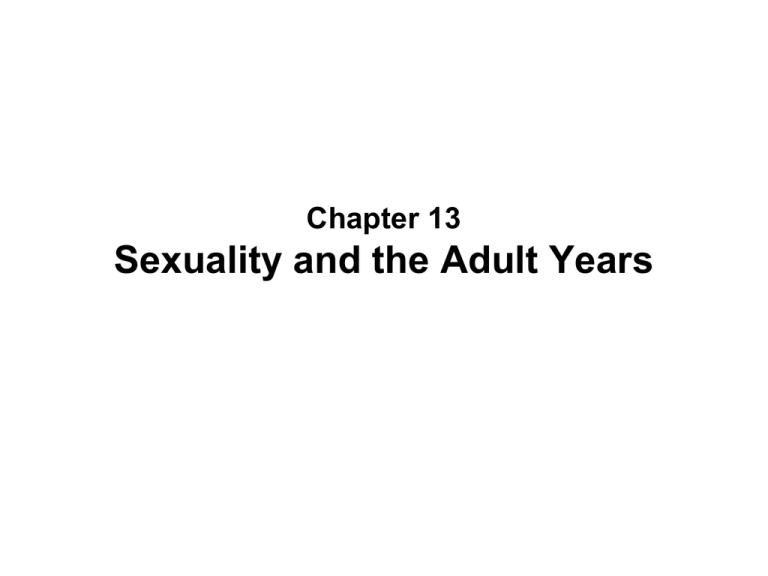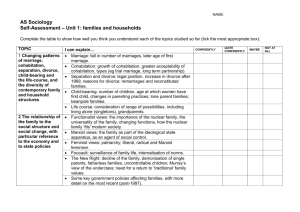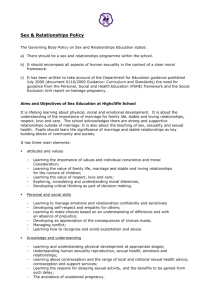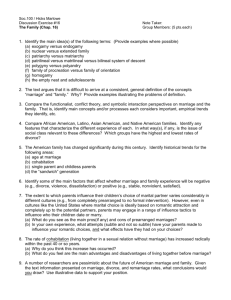
Chapter 13
Sexuality and the Adult Years
Single Living
• Increasing rates
• May reflect change in societal attitudes
• Lifestyle and satisfaction vary widely
– Celibacy or long-term monogamy
– Serial monogamy
– Single persons engage in sexual activity less often
and are less satisfied than married persons
Cohabitation
•
•
•
•
Domestic partnership
Cohabitation vs. marriage
Social impact
Similarities and differences between
cohabitation and marriage
• Impact before marriage
Cohabitation
Men’s Cohabitation Rates by Educational
Level
Marriage
•
•
•
•
•
•
•
Stable families convey social norms
Defines rights of inheritance
Regulates sexual behavior
Emotional and social support system
Associated with better health
Takes different forms in different cultures
Same-sex and interracial marriage
Marriage in Current Collectivist and
Individualist Cultures
• Collectivist cultures
–
–
–
–
Emphasize group goals over individual
Marriage unites families not two individuals
Arranged marriages common
Emphasize needs of family, community, or religion;
de-emphasize love
– Polygamy
• Individualistic cultures
– Emphasize feelings of love
– Importance of love is a recent innovation
Changing Expectations and Marital
Patterns
• Discrepancy between American marriage ideal
and actual practices
– Most politically conservative areas (“Bible Belt”) have
some of the highest rates of divorce and unwed
mothers
•
•
•
•
Unrealistic expectations of fulfillment
Fewer support networks for marriage
Lack of preparation for daily issues
People live longer
Predicting Marital Satisfaction
Gottman’s Research
• Based on heterosexual couples
• Ratio of positive to negative comments predict
satisfaction
• Five positive to one negative interaction is key
Sexual Behavior and Satisfaction in
Marriage
• Factors that raise sexual satisfaction
• Factors that lower sexual satisfaction
• Sexless union can be satisfying
– DINS (Dual income, no sex)
Extramarital Relationships
• Cultural differences
– Most cultures have restrictive norms; usually more
restrictive for women
• Consensual
– Swinging, open marriage, and polyamory
• Nonconsensual
–
–
–
–
Varied and complex reasons
Younger people have more affairs
Role of Internet
Impact on marriage varies
Divorce
• Almost half of all first marriages end in divorce
• Reasons for high divorce rate
– Increased expectations for marital and sexual
fulfillment
– No-fault divorce laws
– Reduction in social stigma
– Women’s economic independence
Reasons People Give for Divorce
• Communication problems
• Basic unhappiness
• Incompatibility
• Drug abuse and physical abuse
Sexuality and Aging
• Aging associated with sexless time
• Double standard for aging
• Health is most crucial to sexual well-being
Sexuality and Aging
Sexual Activity in Later Years
• Among sexually active adults over age 60: 61%
said their sex life today was either the same or
more physically satisfying than in their 40s
• Factors that maintain activity
–
–
–
–
Prior interest in sexual activity
Regularity of sexual activity
Good physical health
SES
Sexuality and Aging
Homosexual Relationships in Later Years
• Same-Sex sexual activity in later years is similar
to heterosexual
• Lesbian advantages
– Less likely to be widowed
– Higher pool of alternatives
– Less aging double standard
Widowhood
• Widows to widowers ratio = 4:1
• 50% of widowers remarry
• 25% of widows remarry
• Older people remain interested in sex even
when no partner is available







